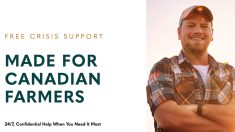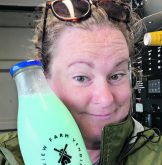Picking a professional to help with a farm transition is a critical consideration, but it can be as simple as who answers the phone.
That’s how Brent and Pam Sattler came to hire Ray Riel — although he had been recommended through a farm succession planning course.
They say it took a few meetings to be comfortable with each other. After all, he needed to know everything about them, and they needed to trust him.
“One of the first things I noticed about Ray was his ability to just sit and listen and take in exactly what you were thinking. He’s developed some truly amazing algorithms to analyze what position you’re at financially to see whether you’re in a position or not to retire,” said Brent. “His communication skills and his algorithms that he personally developed were selling points for us.”
The couple said they are comfortable communicating in writing but less so when speaking to others, including their kids when discussing whether they wanted to farm.

Riel began focusing exclusively on farm transition about five years ago after a career in business and financial planning.
He grew up on a farm and understands the challenges faced by those who have been on the land for generations, particularly when there isn’t a successor.
“That’s an entirely different dynamic because you’re dealing with someone maybe who’s gotten up for the last 50 years of their life with a clear sense of purpose of what they needed to get done, how to do it, the value of it and the meaning of it, and being part of something that was bigger than themselves,” he said.
“When they think about exiting the farm, it’s hard for them to see beyond that because sometimes all they see is the vacuum. So, it’s easy to delay the decision-making process.”
Read Also

Producer profits remain under significant pressure
Manitoba farmers are facing down a double hit of high input costs, like fertilizer, and low grain prices as they harvest their next crop.
Riel encourages people to start with the emotional side of the decision and think about what’s most important to them.
Some will say it’s money to ensure a comfortable retirement. Others, like the Sattlers, say fair market value is great but it isn’t necessarily the priority.
“Does it matter how (potential buyers) are going to farm it? (To) some farmers it makes a real difference and the next farm family not so much. Does it matter if the land remains locally owned? Does it matter if the new owner is going to be part of the community or is it going to be farmed by a major operation where the owners are maybe out of the province or a different part of the province?”
Sometimes a combination is possible, such as helping a young farmer with financing while protecting the exiting farmer’s interests.
Riel said having values that align with the new buyer can make it easier all around.

When the Sattlers’ plans switched from succession to exit, they had a clear set of priorities for the sale. Riel acted as a third party to contact a potential purchaser and then devise a process that was fair to buyer and seller.
Starting with an agreed-upon set of numbers, through a third-party professional appraisal, provides an objective starting point for both parties.
Riel said that gets the conversation started. “Then we start looking at time. We start looking at funding,” he said.
Again, he said people aren’t always aware of the many options.
“It’s important to surround yourself with advisers who are very familiar with the ag sector, who understand the tax law and the complexity that comes with it,” Riel said. “Also, I think it’s important for the farmers to share their values with their advisors: ‘this is what’s important to us about this transition. This is what we’d like to accomplish.’ ”
He said sellers might want to interview two or three advisors, particularly with the large operations of today.
“The level of complexity from extracting yourself from a corporate farm, for example, can be horrendous,” he said.
Advisors who helped someone start farming might not be the best when someone is leaving.
As a financial planner Riel said he had mostly incorporated professional clients but every so often a farmer would come in.
“It became clear to me that there was a massive gap between advisory streams,” he said.
Traditional advisors work for companies with something to sell, such as an investment or life insurance. Farmers also consult accountants, lawyers, neighbours and family members as they struggle to make decisions.
“It’s massively complicated,” said Riel. “You’re dealing with once-in-a-lifetime decisions that there’s no do-overs. You’ve got to get it right.”
That’s why he left the traditional planning model and offers only advice.
“I work for the farmer and only for the farmer,” he said. “I have no agenda.”
Along the way Riel also developed software that is specific to farm transition and develops scenarios so farmers can see how best to proceed.
One of the common issues is how to deal with children who aren’t involved with the farm but grew up there and do have a sense of ownership. Many will use life insurance to handle that, but Riel said there are other possibilities.
His software looks at the tax implications of different strategies and produces reports for the client’s accountant.
It also generates reports that are easier for people without accounting backgrounds to understand. That allows them to realistically compare their options.
Riel said many farmers are well served by local accountants or bookkeepers but might need more “bench strength” when selling out, particularly if their farms have become very large.
He said about 75 percent of his work involves farm transitions to another generation. Often the farmers have re-invested everything into their farms and have set aside little for themselves.
“They may have a child who wants to farm, and they might have two or three others that don’t,” he said. “Now the farm has to service the needs of the retiring farmer… It has to be able to provide for both the young family that’s perhaps relocating on to the farm. Sometimes it’s simply not doable with smaller operations and so we have to look at other options.”
Sometimes, the situation is the exact opposite, where major assets are locked in a company.
“How do you extract that from a corporate environment and then come up with an equalization strategy for the non-farming kids? Sometimes the parents are not insurable, so what does that look like?
“Sometimes it might be a combination of carving off a piece of the land base or the farm and then transferring that to the non-farming kids in such a manner that the farming children still have control of that piece of land.”
Riel noted the downside with insurance is that children can wait a long time for benefits if their parents are healthy, yet they might need the money sooner.
Transferring a small piece of the land base to the non-farming children allows them to get income from the land and there is often a legal mechanism that requires them to sell to the farming child if they decide to sell.
Riel said larger farms present another level of complexity in terms of transition. Many farms grew large without thought of succession, he said.
“If a farmer wants to make it easy for their successor, they need to max out their RRSPs, max out their TFSAs, bring in as much off-farm savings into themselves personally, maximize their entitlements, their CPP, their Old Age Security, so they give the farm every opportunity to be successful by not having to pay them out.”
Riel also suggested that farmers invest in themselves, by taking accounting, farm management, human resources or leadership training.
“If you’re dealing with family dynamics and if you are looking at setting up a multi-million-dollar operation you need to have clear direction. And where is that direction going to come from? So sometimes leadership training can go a long way in helping it move forward.”
Riel said having these conversations is difficult but that’s where he comes in. He spends a lot of time getting to know his clients and learning what they really want to do.
“I spend sometimes almost as much time with the non-farming kids as I do with the parents,” he said.
Parents want to be fair and determining that without advice can be hard. Transition planning is easier in families for whom financial conversations are daily occurrences, Riel said.
RIEL’S SUCCESSION PLANNING TOP 10 LIST:
Recognize that succession planning is often a compromise, for founders, successors and non-farming children.
Successors who share the same values and work ethic as founders will find greater support throughout the transition. Share and discuss your vision of what the farm will look like post-transition.
Don’t count on conversations, assumptions, expectations, intentions or wills! Written transition plans along with written agreements (reviewed by your lawyer, cpa and planner) that survive death, disability or divorce are key to transferring farm property with certainty.
Clearly identify and communicate what keeps you up at night. (Farm viability, divorce, family harmony, estate distribution).
Invest in your successor. Developing a successor’s financial literacy and leadership skills are key for both small and especially larger farming operations.
Succession planning is often focused upon the founders, and life insurance can play a role in estate equalization strategies, but don’t overlook a successor’s exposure to risk and their estate planning (wills), especially if they have minor children.
Regular farm business meetings between founders and successors are especially important for transitioning a lifetime of learning and experience and developing communication skills.
Designate someone in the family to quarterback the process or hire a financial professional who can act as your transition manager who has a defined transition process and can function as negotiator, technical interpreter and motivator.
Build up your personal savings. Otherwise, your farm will need to one day support two families.
RIEL’S EXIT PLANNING TOP 10 LIST:
Recognize that exiting a farming operation that may have been part of your family history is as much an emotional event as it is a financial event.
Give some thought to what will be important to you in this transition and what you value. For example, is it important that:
• The land remains locally owned?
• The buyer shares your farming philosophy, ie: organic, conventional?
• Would you consider a strategy that would guarantee a good price and your proceeds, yet give a young farmer a break?
• Do you want to exit completely, or would you prefer to continue to own some or all of your land but simply step back from the manual work?
Write down your values and priorities, and discuss them.Your values inform your priorities, and as such can help guide the process.
Clearly identify and communicate what – in the exit process, keeps you up at night, ie; activities and engagement post transition, family harmony, estate distribution etc.
Build a team of professional advisors to help with your transition. The ag sector has unique tax law and unique financial strategies that can have a significant impact on your transition and eventual retirement. Especially important for incorporated farms.
Recognize that sometimes existing advisors might not be the best choice to manage a once in lifetime exit.
Consider hiring an experienced professional who only works for you, and can act as your “Transition Manager”, who has a defined transition process and can help you explore your options and function as negotiator, and technical interpreter.
Plan on how you will remain physically and mentally active post transition.
Often post transition, farmers no longer manage land and equipment assets, but cash and investment assets. Consider taking a course on how to do so effectively.
Be patient with yourself and your spouse during the process and take care.

















